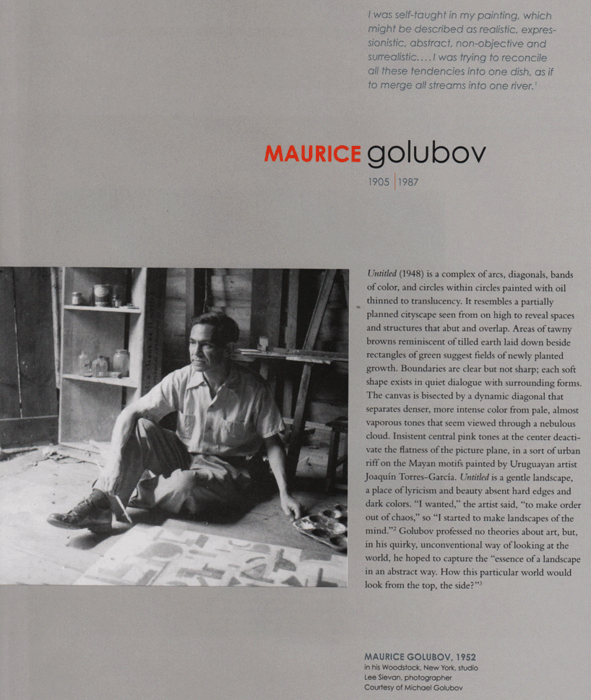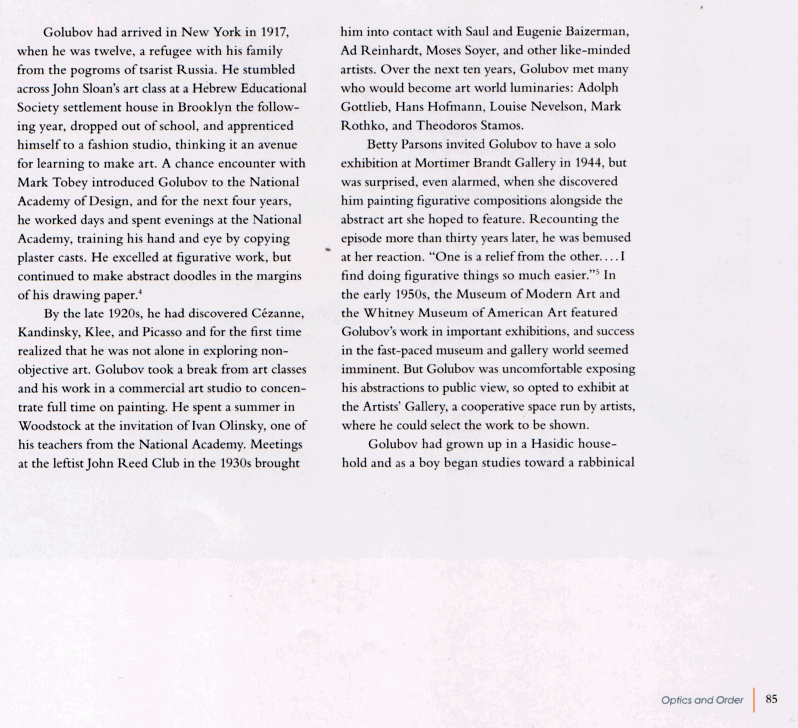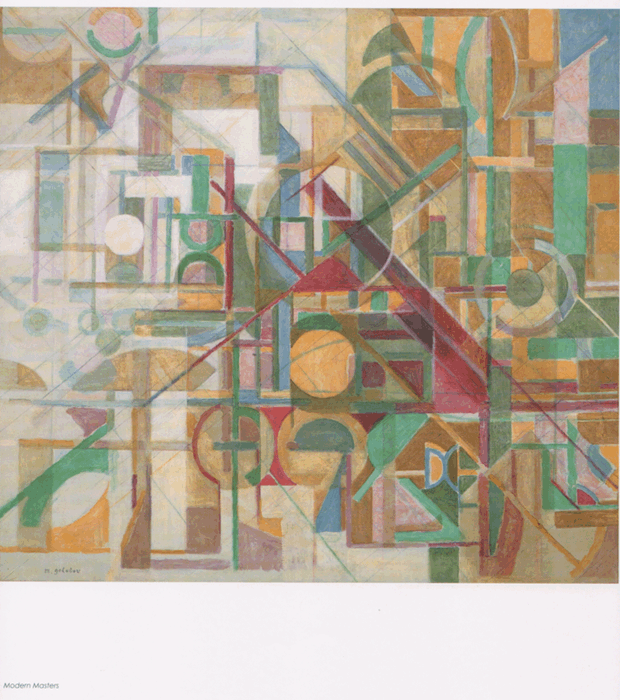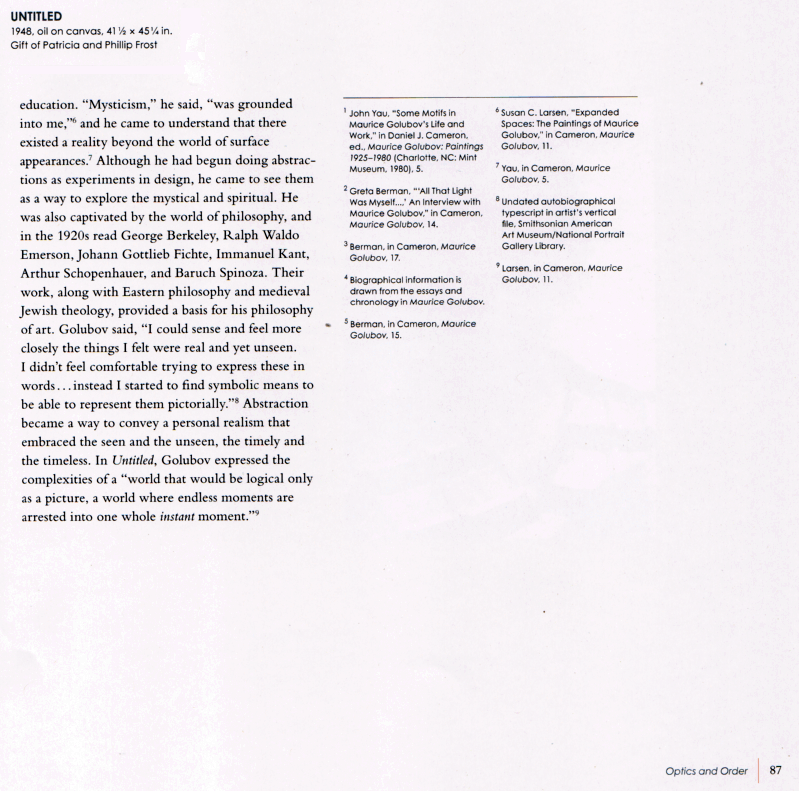Maurice Golubov was featured in the American Abstraction at Midcentury Modern Masters from the Smithsonian American Art Museum.
Untitled (1948) is a complex of arcs, diagonals, bands of color, and circles within circles painted with oil thinned to translucency. It resembles a partially planned cityscape seen from on high to reveal spaces and structures that abut and overlap. Areas of tawny browns reminiscent of tilled earth laid down beside rectangles of green suggest fields of newly planted growth. Boundaries are clear but not sharp; each soft shape exists in quiet dialogue with surrounding forms. The canvas is bisected by a dynamic diagonal that separates denser, more intense color from pale, almost vaporous tones that seem viewed through a nebulous cloud. Insistent central pink tones at the center deactivate the flatness of the picture plane, in a sort of urban riff on the Mayan motifs painted by Uruguayan artist Joaquin Torres-Garcia. Untitled is a gentle landscape, a place of lyricism and beauty absent hard edges and dark colors. “I wanted”, the artist said, “to make order out of chaos,” so “I started to make landscapes of the mind.” Golubov professed no theories about art, but, in his quirky, unconventional way of looking at the world, he hoped to capture the “essence of a landscape in an abstract way. How this particular world would look from the top, the side?”
Golubov had arrived in New York in 1917, when he was twelve, a refugee with his family from the pogroms of tsarist Russia. He stumbled across John Sloan’s art class at Hebrew Educational Society settlement house in Brooklyn the following year, dropped out of school, and apprenticed himself to a fashion studio, thinking it an avenue for learning to make art. A chance encounter with Mark Tobey introduced Golubov to the National Academy of Design, and for the next four years, he worked days and spent evenings at the National Academy of Design, and for the next four years, he worked days and spent evenings at the National Academy, training his hand and eye by copying plaster casts. He excelled at figurative work, but continued to make abstract doodles in the margins of his drawing paper.
By the late 1920s, he had discovered Cezanne, Kandinsky, Klee and Picasso and for the first time realized that he was not alone in exploring non-objective art. Golubov took a break from art classes and his work in a commercial art studio to concentrate full time on painting. He spent a summer in Woodstock at the invitation of Ivan Olinsky, one of his teachers from the National Academy. Meetings at the leftist John Reed Club in the 1930s brought him into contact with Saul and Eugenie Baizerman, Ad Reinhardt, Moses Soyer, and other like-minded artists. Over the next ten years, Golubov met many who would become art world luminaries: Adolph Gottlieb, Hans Hofmann, Louise Nevelson, Mark Rothko, and Theodoros Stamos.
Betty Parsons invited Golubov to have a solo exhibition at Mortimer Brandt Gallery in 1944, but was surprised, even alarmed, when she discovered him painting figurative compositions alongside the abstract are she hoped to feature. Recounting the episode more than thirty years later, he was bemused at her reaction. “One is a relief from the other….I find doing figurative things so much easier.” In the early 1950s, the Museum of Modern Art featured Golubov’s work in important exhibitions, and success in the fast-paced museum and gallery world seemed imminent. But Golubov was uncomfortable exposing his abstractions to public view, so opted to exhibit at the Artists’ Gallery, a cooperative space run by artists, where he could select the work to be shown.
Golubov had grown up in a Hasidic household and as a boy began studies toward a rabbinical education. “Mysticism,” he said, “was grounded into me,” and he came to understand that there existed a reality beyond the world of surface appearances. Although he had begun doing abstractions as experiments in design, he came to see them as a way to explore the mystical and spiritual. He was also captivated by the world of philosophy, and in the 1920s read George Berkely, Ralph Waldo Emerson, Johann Gottlieb Ficthe, Immanuel Kant, Arthur Schopenhauer, and Baruch Spinoza. Their work, along with Eastern philosophy and medieval Jewish theology, provided a basis for his philosophy of art. Golubov said, “I could sense and feel more closely the things I felt were real and yet unseen. I didn’t feel comfortable trying to express these in words… instead I started to find symbolic means to be able to represent them pictorially.” Abstraction became a way to convey a personal realism that embraced the seen and unseen, the timely and the timeless. In Untitled, Golubov expressed the complexities of a “world that would be logical only as a picture, a world where endless moments are arrested into one whole instant moment.”




